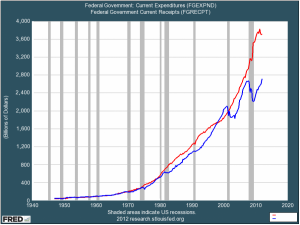“There is great anger that Obama could force higher tax rates on small businesses simply by saying no.”

by Grover Norquist
The 2001 and 2003 “Bush tax cuts” were enacted with an expiration date because 60 votes are required in the Senate to make a tax cut permanent. Other tax cuts such as the “patch” limiting the Alternative Minimum Tax and the Research and Development Tax Credit would lapse every two years giving politicians an opportunity to “sell the same horse” again and again to voters and campaign contributors.
Hence the “fiscal cliff” of an automatic tax increase scheduled for Jan. 1, 2013 that would result in taxes increasing $500 billion in that one year alone as all these “temporary” tax cuts lapsed together. Only legislation passed by the Democratic-controlled Senate, the Republican House, and signed by President Barack Obama would stop the tax increases.
The world was upside down. Normally it takes the House, Senate and president acting together to raise taxes. Now it would take all three to stop any or all of the tax cuts from lapsing—and from taxes increasing on all Americans.
This Alice in Wonderland situation flowed from the modern Democratic Party’s hostility to tax reduction. Back in 1981 the Reagan tax cuts were made permanent. The Tax Reform Act of 1986 reduced the top rate from 50 percent to 28 percent—permanently.
The legislation passed by the House, Senate and now signed by the president that makes 85 percent of the Bush tax cuts permanent is a bittersweet victory or defeat. Income tax rates fall for 99 percent of Americans. Those reductions are now permanent. And yet Americans rightly worry about Obama’s ability to force the top rate to automatically jump back to Clinton’s 39.6 percent from Bush’s 35 percent. Obama won his class warfare pound of flesh.
One hundred and fifty seven House Republicans voted “no” on the legislation to make most of the Bush tax cuts permanent out of understandable frustration that there was no vote or action they could have taken to restore the full Bush tax cut.
So now what?
Now the tables have turned. The income tax rates and important credits and deductions are now permanent. It takes an affirmative vote by the House and Senate to increase taxes ever again. (Good luck with that, Mr. President.)
And what about spending? Were we not promised jillions of dollars in spending reduction in return for tax increases? Was that not the mantra of the Washington Establishment, the promise of the 2010 bipartisan panel that came to be known as the Simpson-Bowles commission? That was always a fool’s errand, the Lucy-and-the-football ploy that defeated and humiliated Republicans in 1982 and 1990.
We now leave a battlefield where the proponents of bigger government had the upper hand—the default position was a $500 billion a year tax hike—to one where the default position is cut spending.
Three virtuous “fiscal cliffs”
There are now the three virtuous “fiscal cliffs.” First, the sequester. If Congress does nothing, unless the House, Senate, and President Obama agree on an alternative, there is an automatic sequester of $1.2 trillion over the next 10 years. One hundred billion dollars in spending cuts a year—automatically. House Republicans have already offered an alternative savings package of the same amount that shifts the cuts from defense to other areas.
The second virtuous cliff is the debt ceiling Obama is spending—again—at a rate that runs up more than $1 trillion in deficits each year. He must come back hat in hand to ask for a debt ceiling increase. The “Boehner rule” first applied with great effect in 2011 requires a dollar-for-dollar savings to “pay” for any debt ceiling hike. Obama wants/needs $1 trillion dollars in debt ceiling—so, he needs to come up with $1 trillion in reduced spending. Or not increase in the debt.
In 2011, conservatives won a $2.5 trillion spending cut in return for the higher debt ceiling.
The third lever for conservatives in the fight to limit federal spending is the fact that the Democrats in the Senate no longer do budgets. It is too embarrassing to write and vote on budgets that clearly run up trillions in debt. So our federal government operates on a series of “continuing resolutions” that allow money to be spent for a month or six months or a year.
Now Republicans in the House can offer Obama another month of “allowance” in return for actual cuts in spending. This worked in early 2011 and was abandoned as a strategy only because the slow pace of progress frustrated them. Now Republicans understand that slow progress is the only road to limiting the damage Obama’s spending is doing. There is no partner available for a grand bargain. Obama does not wish to reform entitlements or end his Chicago style “pay to play,” “pork for the boys” tax and spend policies.
Three levers to control spending. This time they are in our hands.
There is great anger that Obama could force higher tax rates on small businesses simply by saying no. Now is the time to channel that anger and energy into the very winnable fight against Obama overspending.
~
Grover Norquist is president of Americans for Tax Reform. This article first ran in Human Events on January 8, 2013.